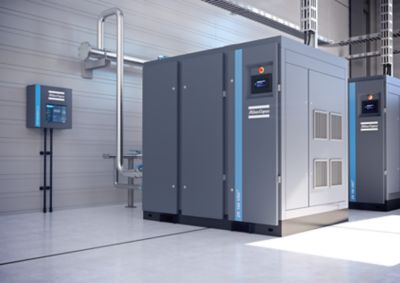A guide to industrial hydrogen compressor safety
Working with any type of fuel poses risks, and hydrogen is no exception.
The main threat is that of an explosion if precautions have not been taken. Whenever there is a fuel source, it “only” takes oxygen and an ignition source (for example a spark or a source of heat) to create a potentially combustible mix.
That is why any hydrogen compressor safety features and best practices must be followed to ensure that these three explosive “ingredients” are kept away from each other.
Engineering and non-engineering measures
There are two ways to minimize the dangers of compressing hydrogen, which needs to be used together to make using the gas as safe as possible.
First, you can mitigate these risks by professionally installing your hydrogen compressor in a secure location.
Specifically, that means a space with good ventilation. In cases where compressors are set up outdoors, the compressors must also be protected from environmental influences, such as rain or direct sunlight. This can be accomplished with a canopy or by placing the compressor in a container.
When selecting the compressor itself, you should make sure that it meets certain requirements to optimally protect your operation and your team.
Electrical safety measures
Compressors with an electric motor must meet the electric classification requirements for equipment operated in a hydrogen environment (Zone 1 ATEX). In addition, it is important to ensure that all hydrogen equipment is bonded and grounded. These steps will reduce ignition sources.
The space around the compressor is classified as a hazardous area and should be free from potential ignition sources.
To do so, you should consult sources such as NFPA 70, National Electric Code (NEC), Article 500 and EN 60079-10-1: ATEX Standard and Classification of Areas with Presence of Gas (ATEX). Note that electrical components used for a hydrogen system should meet the requirements of the NEC’s Class 1, Division 1 or 2, Group B of the NEC or those of ATEX.
Any equipment that is not specifically rated to be used in hazardous requirements has to be located outside of the specified area.
Preventing leaks and hydrogen buildups
Having minimized potential ignition sources in this way, the next step is to prevent a dangerous accumulation of hydrogen.
The passive ventilation offered by an outdoor installation will help. However, active ventilation measures should also be taken, for example venting ports that release hydrogen to a safe area.
Note: Vent fans should consist of non-sparking materials such as plastic or aluminum.
To prevent a buildup of hydrogen, it is important to detect and prevent leaks.
The wear parts of reciprocating compressors will always result in tiny leaks, which is why ventilation is important.
Compressors should always be provided with vent ports to allow theat any leak for gas selas are vented to a safe location. Having said this, a safe system should always also include leak detectors.
As noted above, hydrogen flames are invisible, which is why the compressor environment should also feature special flame detectors.
To make sure that all these safety systems work together, it is best to use a compressor controller that can communicate with these safety devices.
Our gas compressors are designed specifically with your safety in mind.
The importance of hydrogen compressor maintenance
Whenever dealing with a potential hazard, it is essential to follow the recommended maintenance schedule and use genuine spare parts.
In the case of hydrogen compressors, that means leak testing, checking the continuous flow of vent systems, performing checks of valves and instruments, and ensuring that all relevant equipment is properly calibrated.
Because hydrogen can cause materials to become brittle, you should also regularly check all connections for signs of corrosion, erosion, cracking, bulging, blistering, or any other deterioration.
A plug-and-play containerized hydrogen solution
There is a lot to keep in mind to optimally protect your operation and your team from the dangers of hydrogen gas.
So, would not it be great if somebody could just deliver a compressor system straight to your facility that includes all these safety features?
Atlas Copco offers plug-and-play containerized hydrogen solutions that incorporate all the safety features and measures described above. In other words, you do not have to worry about whether the equipment is properly rated, whether your ventilation is adequate or whether the controller is connected to leak or flame detectors. That is because all of it is included.

